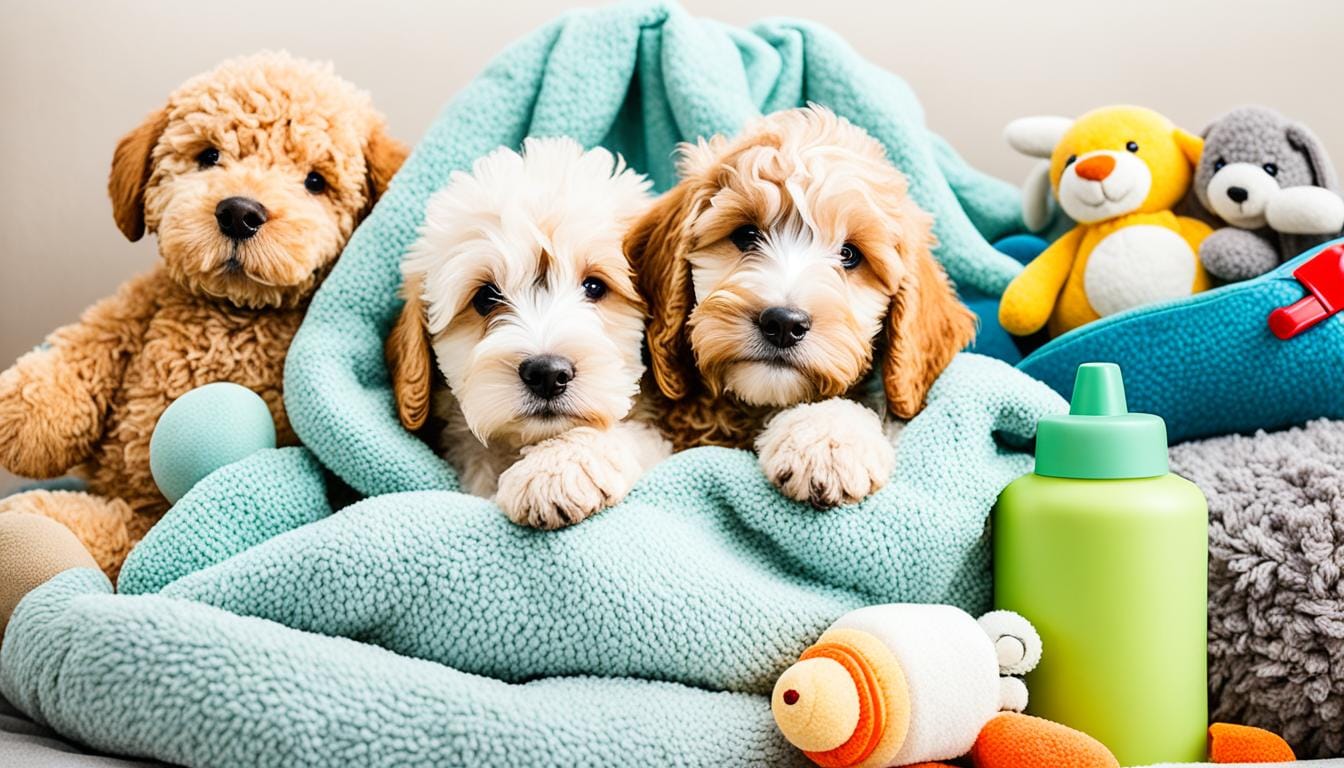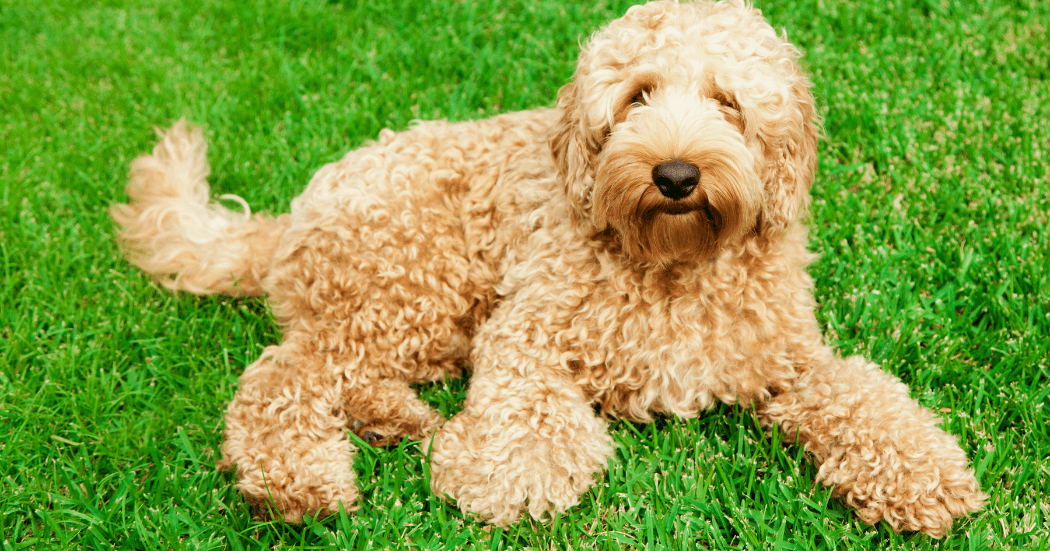Welcome to the complete guide for labradoodle puppy owners. This guide has everything you need to know to take care of these lovable, smart dogs. We’ll show you how to set up care routines and train them well. With the mix of Labrador Retriever and Poodle in their blood, labradoodles are cute and learn fast. Use this guide to make sure your labradoodle is happy from its puppy years to when it’s all grown up.
Labradoodles are a special blend of Labrador Retriever and Poodle. They have soft, curly fur and are bursting with love and energy. Being hypoallergenic, they are great for families with allergies. Taking good care of your labradoodle means feeding them right, keeping them well-groomed, and checking their health often. Following this guide will help you with every step of raising your new four-legged family member.
Key Takeaways
- Labradoodles are a mix of Labrador Retriever and Poodle, known for their curly fur and energetic nature.
- Optimal feeding schedules involve small, regular meals throughout the day.
- Regular grooming, including brushing, prevents mats and tangles.
- Frequent vet visits in the first year cover vaccinations and preventive care.
- Proper training is crucial to managing their high energy and preventing behavioral issues.
Preparing for Your Labradoodle Puppy’s Arrival
Getting ready for your Labradoodle puppy is key. You need to prepare well for an easy start. This means getting all the supplies you’ll need and creating a warm home.
Essential Supplies
When preparing for labradoodle puppy, make sure you have everything checked off. It’s important for your puppy’s comfort. You’ll need items like:
- Water Bottle: Ensure your puppy always has access to clean, fresh water.
- Baby Wipes: These are handy for quick clean-ups and maintaining hygiene.
- Comfortable Blanket: A cozy blanket helps your puppy feel secure and warm.
- Crate: Useful for crate training and providing a safe sleeping area.
- Leash and Collar: Essential for leash training and guiding your puppy.
- Dry Food: Preferred for dental health and balanced nutrition.
- Chew Toys: Important during the teething period to address chewing needs.
First Steps at Home
Introducing your labradoodle at home is a big deal. Those first few days are crucial for easing your puppy in. Here are quick steps to support this:
- Leash Training: Begin leash training indoors to establish boundaries and build trust.
- Limit Visitors: To avoid overwhelming your puppy, restrict outside visitors for the first few days.
- Crate Use: Encourage your puppy to sleep in the crate for about seven hours during the night to create a sense of security.
- Monitor Movement: Use the leash to guide where your puppy is allowed, reducing anxiety and teaching boundaries.
- Primary Caregiver Bonding: Ensure the primary caregiver spends quality time with the puppy to foster early bonding and trust.
Setting up the right environment and having the correct supplies is important. It helps make preparing for your Labradoodle puppy and introducing them at your home smoother. This way, your Labradoodle starts life in a positive way.
| Item | Purpose |
|---|---|
| Water Bottle | Ensure access to clean water |
| Baby Wipes | Maintain hygiene |
| Comfortable Blanket | Provide warmth and security |
| Crate | Safe sleeping area |
| Leash and Collar | Guide and train your puppy |
| Dry Food | Nutritional and dental health benefits |
| Chew Toys | Assist during the teething period |
Labradoodle Care Tips: Feeding, Grooming, and Health
Caring for your Labradoodle well requires you to look after their food, fur, and health. A good daily routine and care can lead to a joyful and healthy Labradoodle.
Feeding Guidelines
Feeding your Labradoodle right is key to their growth and happiness. At first, puppies need to eat three times daily. But as they mature, switch them to two meals a day. It’s important that they get more than 40 different nutrients, like proteins and vitamins. Commercial dog foods often have these, but homemade meals might need some extras. Things like omega-3 fats, glucosamine, and antioxidants.
Grooming Essentials
Keeping your puppy’s coat in top shape is crucial. Grooming a labradoodle puppy means lots of brushing. This stops their curly hair from turning into mats. Regular grooming early on makes things easier in the future. You should also visit a professional now and then, even though Labradoodles don’t shed much, their hair can get tangled. Starting a good grooming routine from the beginning keeps your Labradoodle happy and clean.
Health Checkups
Regular vet visits are crucial for your Labradoodle’s health. The first year is especially important for vaccines and health tests. Labradoodles might face problems like hip issues and ear infections because of their mixed breed. Regular checkups catch these problems early. This keeps your Labradoodle enjoying a healthy life.
If you need more help, Labradoodle breeders like Hidden Springs Labradoodles in Blackwood, NJ, can assist. You can call them at (856) 981-4800.
The Importance of Socializing Your Labradoodle Puppy
Early socialization is key for a Labradoodle to grow into a friendly and adaptable pet. It makes sure they become confident and well-behaved friends. Not getting enough socialization can cause them to be anxious and lead to behavior problems. So, it’s really important to start socializing your Labradoodle early on.
Early Socialization Techniques
Start socializing your Labradoodle puppy when they’re between three weeks and three months old. Show them lots of new things, like different surfaces and sounds. It’s good for them to meet people of different ages and other animals too. This makes them more friendly.
Classes for puppies, like the ones at Notch Hill Labradoodles, can be a big help. They teach your puppy good manners and give them positive experiences.
Exposure to Different Environments
It’s important for Labradoodles to see more than just their home. They should see parks, streets, and go for car rides. This makes them less scared and more able to handle new places.
By four months old, they should be okay with meeting new people, dogs, and visiting vets. These early, positive experiences help your Labradoodle to be confident and behave well as an adult.
Take Toby, for example. Out of six Labradoodles, Toby was the best-behaved. He had a lot of early socialization training. This made a big difference in his behavior. A good socialization program means you and your Labradoodle will likely have a great relationship. It helps avoid many behavior problems.
Training Your Labradoodle Puppy: Basic Commands and Beyond
Training your labradoodle puppy is a great experience. Their intelligence and desire to please make it fun. Start with basic commands, then move on to more complex training. This shapes them into a well-behaved and joyful friend.
Basic Commands
Begin teaching your labradoodle basic commands early. “Sit,” “stay,” “come,” and “down” are good to start with. Use positive reinforcement – give treats or praise when they do well. Keep training sessions short and fun, usually 5-10 minutes, to keep your puppy interested.
- Plan: Create a regular training time and spot.
- Swap: Use treats to turn bad actions into good ones.
- Reward: Always reward right actions to enforce good behavior.
Books like “The Puppy Primer” by Patricia McConnell can help. They offer extra advice. “How to RAISE A PUPPY You Can Live With” by Rutherford & Neil is another good choice for training.
Advanced Training Tips
After your labradoodle can do the basic commands, you can try advanced training. Use harder commands and fun activities. These activities keep them sharp both physically and mentally. Scent work and fetching games are great for this.
Advanced in-home training for 2 to 4 weeks is an option. This type of training covers better social skills and how to behave in the house. Extra training is good, especially for families with kids. A professional trainer may help if you experience any difficulty.
Keep training your puppy at home even after the program ends. Being consistent can make a big difference. Also, make sure to socialize your puppy well outside. It helps prevent behavior issues like being scared or too aggressive.
| Training Aspect | Details |
|---|---|
| Initial Training Duration | 0-8 weeks |
| Extended Training Sessions | 2-4 weeks |
| Basic Commands | Sit, Stay, Come, Down |
| Advanced Training | Scent Work, Retrieving, Socialization |
Combine basic and advanced training with positive reinforcement. This will help make your labradoodle polite and social. They will do well in all sorts of places.
Using Crates and Playpens for Labradoodle Puppy Care
Labradoodle care routines include crates and playpens. They help your puppy feel secure, not stressed. They give your furry friend a safe space to grow. Crate training teaches your puppy to feel at home in their crate.
Pros of Crate Training
Crate training a labradoodle puppy comes with many benefits. It helps with housebreaking. Your puppy gets a space of their own where they can feel calm. Make sure the crate is the right size for your puppy.
This method helps stop bad habits like chewing on furniture. It gives your puppy a steady routine. This makes them happier and helps reduce stress. Mix crate time with play to make training enjoyable.
When to Use a Playpen
A playpen is great for labradoodle care. It keeps your puppy safe when you’re not watching. Playpens are ideal for short-time confinements.
They teach your puppy to be okay on their own sometimes. Playpens also let your puppy have a safe area to play and rest. This helps them learn without getting into trouble.
Using both crate training and labradoodle playpen techniques adds structure. They make your puppy feel safe. This helps your labradoodle puppy grow up happy and healthy.
Labradoodle Characteristics: Understanding Their Behavior
Labradoodles bring together traits from Labrador Retrievers and Poodles. Knowing their behavior helps you create a great relationship. They are smart, love people, and are very affectionate. Yet, they have unique behaviors owners need to know about.
Personality Traits
Labradoodle personality traits are all about being lively and warm. They love people and need lots of playtime and attention. By playing with them often, you’ll learn more about who they are and strengthen your bond.
They’re quick to learn because they’re smart. But, sometimes their excitement makes them jump a lot, especially when they meet new people.
Common Behavioral Issues
Common issues with labradoodles may include carrying items around and being a bit stubborn. They also have lots of energy, so they need regular exercise to stay happy.
Training is key to dealing with these challenges. Also, make sure they have enough activities for both body and mind.
Labradoodles might also need you to look after their teeth. Don’t forget about their dental checkups and vaccines. These health practices keep them happy and lessen behavior troubles.
| Characteristic | Description |
|---|---|
| Intelligence | High, making them quick learners but also requiring stimulation. |
| Sociability | Extremely friendly, enjoys interaction with humans and other dogs. |
| Energy Levels | High, necessitating regular exercise and activities. |
| Common Behaviors | Jumping in excitement, carrying objects, and occasional stubbornness. |
Getting to know your labradoodle’s behavior and traits is key to a wonderful pet experience. Preparing for their needs helps make life better for both you and your furry friend. Remember, each breed has its special traits. Learning about them helps you give your labradoodle the best care and training.
Fun Activities for Your Labradoodle Puppy
It’s key to keep your labradoodle puppy busy with activities for labradoodle puppies. They need things that fit their energy and brains. You can do this indoors and outdoors, and it’s essential for their happiness and health.
Indoor Games
During bad weather, indoor games are a lifesaver. You can play hide and seek with their toys or treats. This is fun and helps them think and move. Also, using food toys keeps them busy when it’s cold outside.
Change their toys weekly to stop them from getting bored. Have 5-10 toys to switch up. These toys can include puzzles and treat-dispensers. They make your puppy think and keep them entertained.
Outdoor Adventures
Outdoor fun is very important for labradoodles. They love games like fetch and frisbee, as well as just walking. Because of their history, they’re often big fans of water play. Make sure to mix up what you do outside so they stay excited.
Doggie daycare is a great choice for them too. It gives them exercise, social time, and joy. It helps them stay active, make friends, and be happier overall.
Here’s a quick guide to keeping your labradoodle entertained:
| Activity Type | Details |
|---|---|
| Indoor Games | Rotating toys, hide and seek, food-dispensing toys |
| Outdoor Adventures | Fetch, frisbee, water activities, walks |
| Socialization | Doggie daycare, playdates with other dogs |
Whether it’s indoor games for labradoodles or outdoor adventures for labradoodles, variety is key. Mixing up toys, games, and visiting new places keeps your puppy happy and well-behaved. This way, they enjoy a full and interesting life.
Finding Reputable Labradoodle Breeders
The first step in getting a labradoodle puppy is finding trustworthy breeders. Reputable breeders care about the health of the puppies they produce. They check the parent dogs for common health problems. This means the puppies are less likely to get sick.
Good breeders are usually part of groups like the Australian Labradoodle Club of America. They offer a health guarantee for two years. This protects the buyer and the puppy.
It’s important to meet the breeder and the dogs in person before making a decision. This helps you see what the puppy might be like. Breeders who are really good at what they do, like Hidden Springs Labradoodles, keep helping after the sale. They want to make sure every puppy goes to a good home.
Reputable breeders often have happy customers who write good things about them. Choosing a puppy from a good line can keep you from dealing with a lot of vet visits and high bills. It helps you enjoy your pet more, too.
| Criteria | Reputable Breeder Standards |
|---|---|
| Health Testing | Genetic, joint dysplasia, eye problems, heart issues |
| Health Guarantee | At least 2 years with specific requirements for eligibility |
| Registration | Registered with ALCA, ALAA, WALA |
| Public Testimonials | Positive references from satisfied buyers |
The Australian Labradoodle Association of America has kept records for almost twenty years. Since the AKC doesn’t fully recognize the breed yet, these records are very important. They show the dog’s history and if health tests were done right.
These efforts from groups like the ALAA show that breeders are focused on doing a good job. This means owners can be confident in the breeder’s work and the puppy they choose.
Conclusion
As you start to care for your labradoodle, sticking with it is key. You need to give them the best care, training, and love. This summary covers everything you need to know, like what to feed them and how to keep them social and trained.
Training your labradoodle helps you get closer to them. They’re smart and learn fast, which makes training fun. They love to play, making them great for families. Labradoodles come in different sizes and coat types, fitting all kinds of families and homes perfectly.
Your labradoodle will be your companion for many years. Their coats don’t shed much and are good for people with allergies. They love to join in on family fun. By meeting their needs, your labradoodle will not only grow well but also become an important part of your family.























